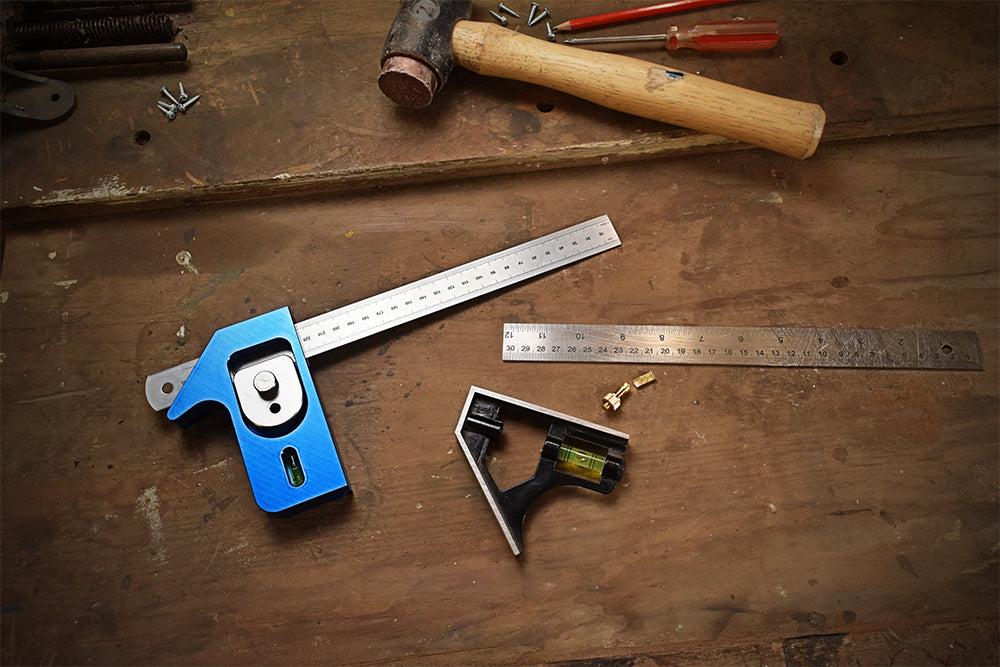
Making a new combination square
Recently, a customer of ours messaged us on Instagram. He was berating his Chinese-made combination squares because they kept breaking and he asked if we could step in and design something better. We don't generally make anything unless it's going to be innovative, so we had to take the time to really look at this project in depth. Combination squares have been made the same way, in that they are locked into position by a hook bolt, for over 100 years.

Push not pull
After testing various ideas, we thought; 'rather than pull the rule into position to lock it, why not push it? By doing it this way we reduce the stress on the parts.'
We also tested various examples of other squares, some cheaper and some more robust, yet they all follow the same design feature, where they have a central groove that runs the length the ruler. This is where the hook bolt engages the rule, and when it's tightened there's a lot of potential for it to go wrong. The bolt is usually very thin and over time they become work hardened.

Could we use it with any ruler?
If you have two parallel edges that are perfectly straight and a good ruler that's sandwiched between the two, like how a machine vice would work, then in theory it should be held firm and square. We use a Moore & Wright rule quite a lot in the workshop and it'd be really handy to just be able to put any kind of ruler in a combination square. We thought 'well what if we wanted to use an eight-inch rule or a 300mm rule even a metre rule? Could we make a square to hold all of those rulers?' So we set about designing one.
Let’s get designing
So far, it looks pretty impressive and we're running the prototype through various tests.

We've added a bolt into the back which is to secure the mechanism internally and stop it from lifting up too much. It seems to be working okay but still not quite enough force.
New Features
The first prototype has several features not currently seen in any combination square. For example; we can use any slimline ruler down to 0.9mm thick. This has the benefit of reducing the likelihood of parallax errors. If you’re unfamiliar with parallax issues it’s basically a visual distortion when there's distance between the mark that you're looking at and the thing you're measuring. For example, if you can imagine being a passenger in a car looking across at the speedometer it may look like the driver's doing 70 miles an hour, but if you're the driver you're looking directly at the speedometer needle and you can see it's actually reading 60mph. I think that's the easiest way to explain it.

The two-part construction means you can service the tool more easily. Every now and again, because of the nature of a combination square, you're going to have to check its squareness. This is because you're constantly sliding the rule in and out and the friction generated eventually wears away material inside of the tool.
So you have to get in there with a file and file away to ensure the rule sits flat and square, easier said than done with a single piece design.
With a two-part construction you should easily be able to file the wear pads down, measure it, check it, use another square to butt up against it, and then file down some more if you need to.
Simple but effective
It’s a simple design so far as components go so in theory, it should last for a long, long time. The quality is evident in feeling the weight of the prototype, the fully CNC machined aluminium, the anodised protective finish. It’s all built to our usual high standards that TrigJig customers have come to enjoy. It should pair really nicely with your favourite workshop rule and be a super handy tool to have around.
However, it is still a work in progress and there are some refinements to be made, but we will keep you posted with any of the updates in the coming weeks. We're waiting on a new machine vice so that we can run a few design changes, for example, we think we're going to go with a slightly more substantial thumb screw so we can get a little bit more leverage when we're clamping.
I Hope you’ve enjoyed hearing about this new product in the pipeline and be stay tuned for more updates!


Comments
Mark Crosby
Love to see your new combination squares. I’ve got the woodpecker combination squares and they have a flip device. That’s on the end of the square so then that tab can be on the work peace without the body falling, over please feel free to contact me and I can explain it better. Look forward to your reply, Mark.
July 28, 2023
Leave a comment